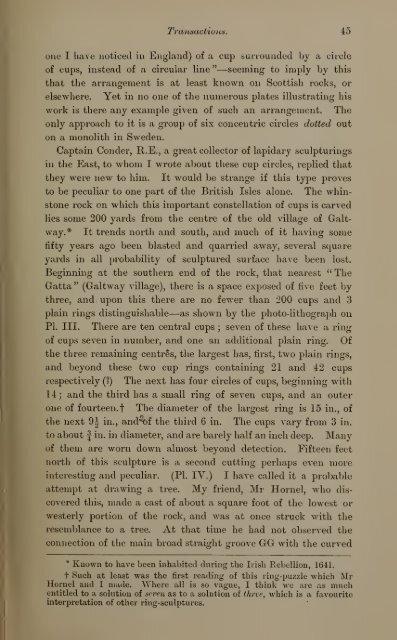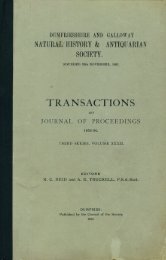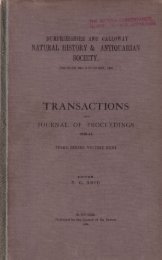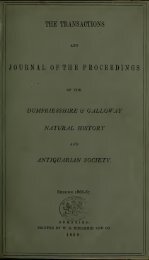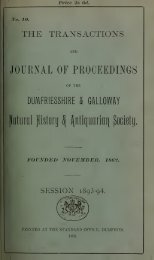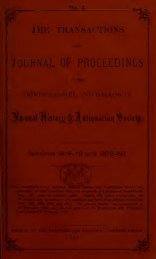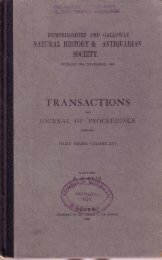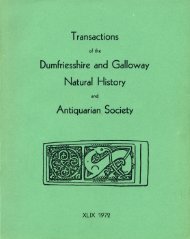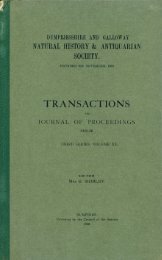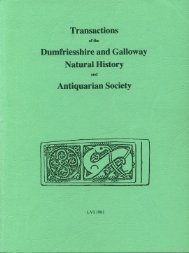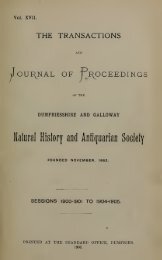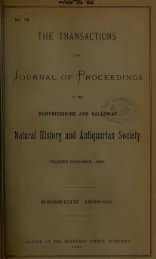Vol 5 - Dumfriesshire & Galloway Natural History and Antiquarian ...
Vol 5 - Dumfriesshire & Galloway Natural History and Antiquarian ...
Vol 5 - Dumfriesshire & Galloway Natural History and Antiquarian ...
You also want an ePaper? Increase the reach of your titles
YUMPU automatically turns print PDFs into web optimized ePapers that Google loves.
IWansactions. 46one I have noticed in Engl<strong>and</strong>) of a cup surrounded by a circleof cups, instead of a circular line " —seeming to imply by thisthat the arrangement is at least known on Scottish rocks, orelsewhere. Yet in no one of the numerous plates illustrating hiswork is there any example given of such an arrangement. Theonly approach to it is a group of six concentric circleson a monolith in Sweden.dotted outCaptain Conder, R,E., a great collector of lapidary sculpturingsin the East, to whom I wrote about these cup circles, replied thatthey were new to him. It would be strange if this type provesto be peculiar to one part of the Bi'itish Isles alone. The whinstonerock on which this important constellation of cups is carvedlies some 200 yards from the centre of the old village of Gaitway.*It trends north <strong>and</strong> south, <strong>and</strong> much of it having somefifty years ago been blasted <strong>and</strong> quarried away, several squareyards in all probability of sculptured surface have been lost.Beginning at the southern end of the rock, that nearest "TheGatta " (Galtway village), there is a space exposed of five feet bythree, <strong>and</strong> upon this there are no fewer than 200 cups <strong>and</strong> 3plain rings distinguishable—as shown by the photo-lithograph onPI. III. There are ten central cups ; seven of these have a ringof cups seven in number, <strong>and</strong> one an additional plain ring. Ofthe three remaining centres, the largest has, first, two plain rings,<strong>and</strong> beyond these two cup rings containing 21 <strong>and</strong> 42 cupsrespectively (?) The next has four circles of cups, beginning with1 4; <strong>and</strong> the third has a small ring of seven cups, <strong>and</strong> an outerone of fourteen.! The diameter of the largest ring is 15 in., ofthe next 9|^ in., <strong>and</strong>'bf the third 6 in. The cups vary from 3 in.to about I in. in diameter, <strong>and</strong> are barely half an inch deep. Manyof them are worn down almost beyond detection. Fifteen feetnorth of this sculpture is a second cutting perliaps even moreinteresting <strong>and</strong> peculiar. (PI. IV.) I have called it a probableattempt at drawing a tree. My friend, Mr Hornel, wlio discoveredthis, made a cast of about a square foot of the lowest orwesterly portion of the rock, <strong>and</strong> was at once struck with theresemblance to a ti-ee. At that time he had not observed theconnection of the main broad straight groove GG with the curved* Known to have been inhabited during the Irish Rebellion, 1641.t Such at least was the first reading of this ring-puzzle which MrHornel <strong>and</strong> I made. Wliere all is so vague, I think we are as muchentitled to a solution of seven as to a solution of three, which is a favouriteinterpretation of other ring-sculptures.


